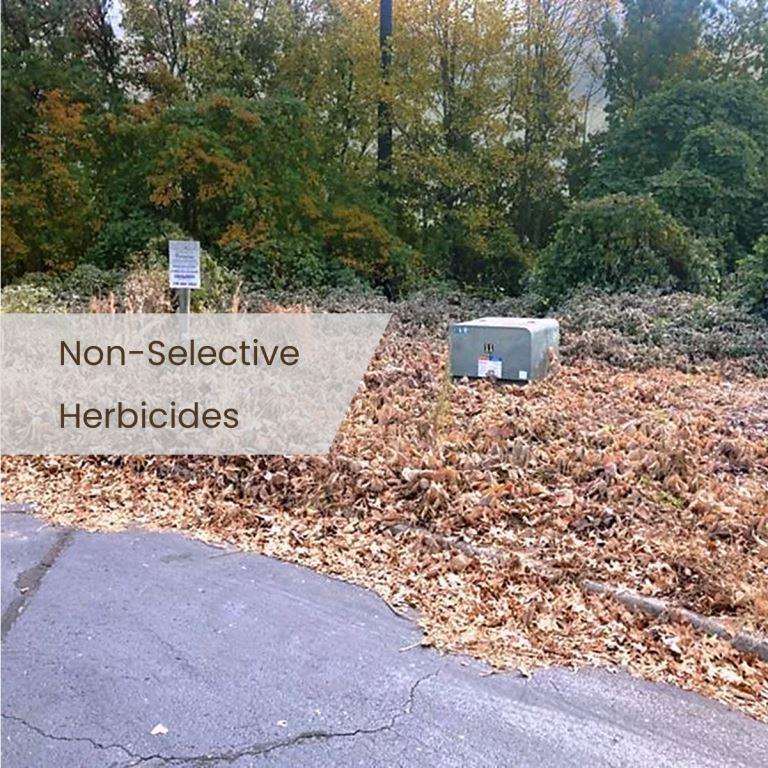
Non-selective Herbicides
Intended to injure, prevent or inhibit growth of all types of vegetation. Either through foliar herbicide absorption, systemic spread, or soil residual root uptake.

You Are Here: VegClear Home > Herbicides

Intended to injure, prevent or inhibit growth of all types of vegetation. Either through foliar herbicide absorption, systemic spread, or soil residual root uptake.
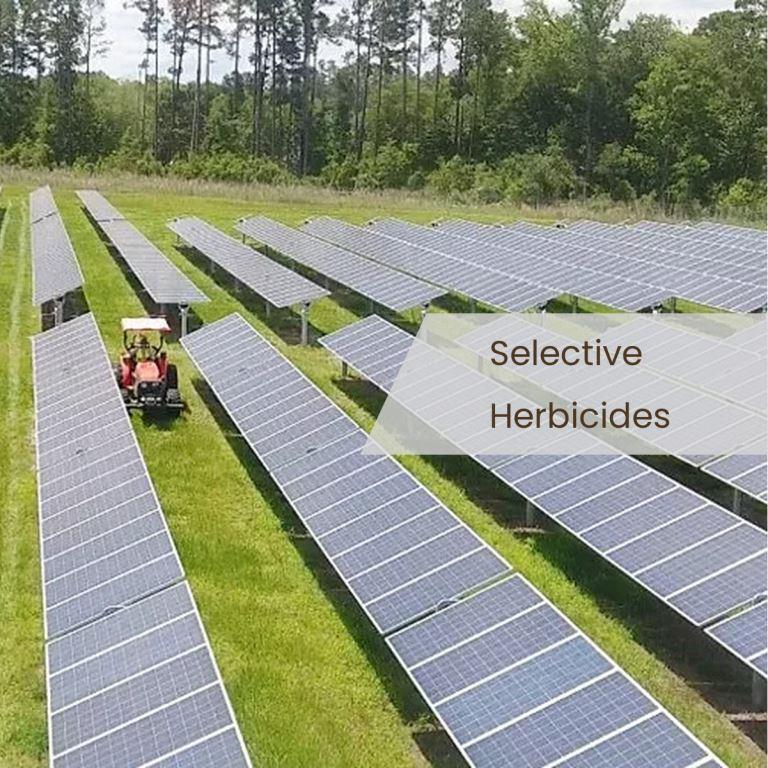
Controls specific types of vegetation used to selectively kill or manage certain plant(s), while not harming others. Selectivity can be chemically or application method derived.
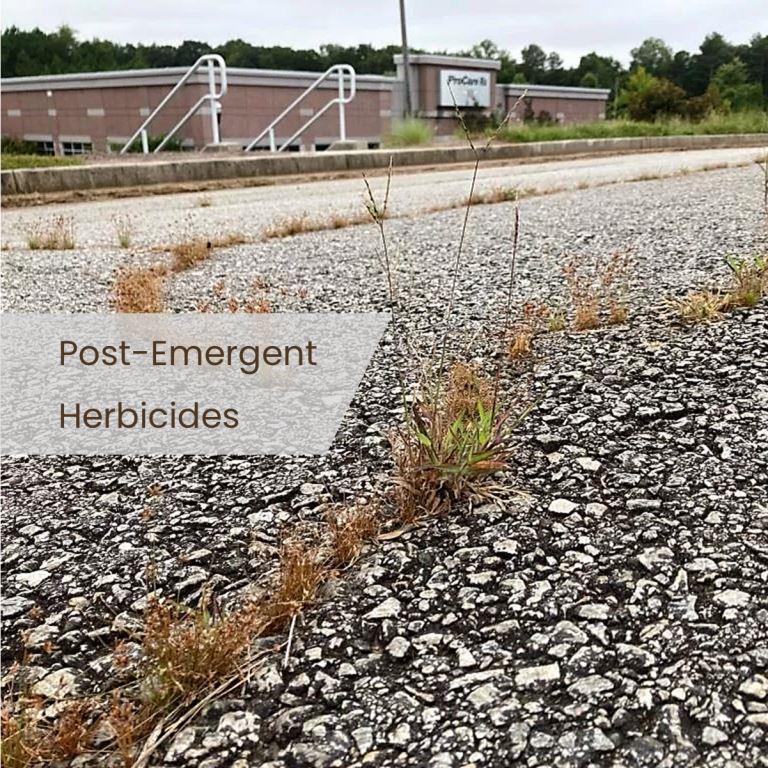
Products that control weeds after they emerge can be foliar and/or soil active to kill existing growth. It causes brownout and visible vegetation damage.
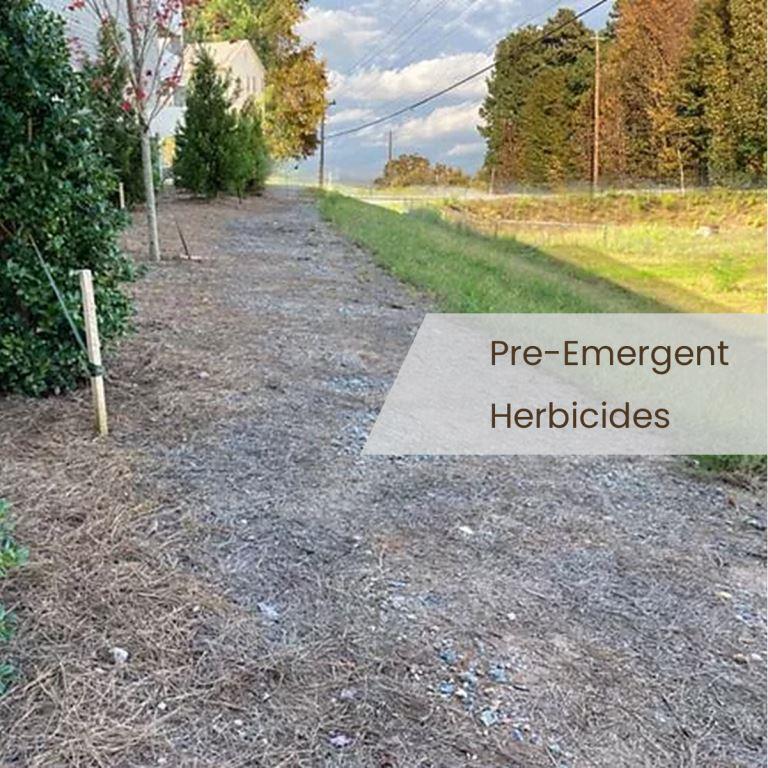
Soil active (residual) herbicide options are applied prior to plant emergence or seed germination. They act on plant seeds as or before they germinate, preventing growth.
Industrial Vegetation Management is a critical service for maintaining the integrity and safety of commercial areas. Important sites include powerlines, pipelines, and industrial properties. VegClear brings decades of experience providing efficient, cost-effective, and safe vegetation management services. Our team of professionals has industrial vegetation control expertise to customize our approach to the specific needs of each site and client. We utilize a range of application methods and products, including non selective herbicides, for low volume backpack applications. In addition we offer high volume blanket applications, boom and boomless wide area spraying. We are committed to adhering to best management practices, regulatory compliance, and proper label adherence. Our team is focused on maintaining the highest safety standards. With teams throughout the Southeast, we have the resources and expertise to manage projects throughout Georgia and surrounding states in the US. In addition to handling routine IVM needs, we also specialize in addressing invasive plants and noxious weed control. We develop site-specific vegetation management plans based on characteristics of each program. By partnering with VegClear, you will save time and money while ensuring cost effective and responsible management of your industrial & commercial properties.
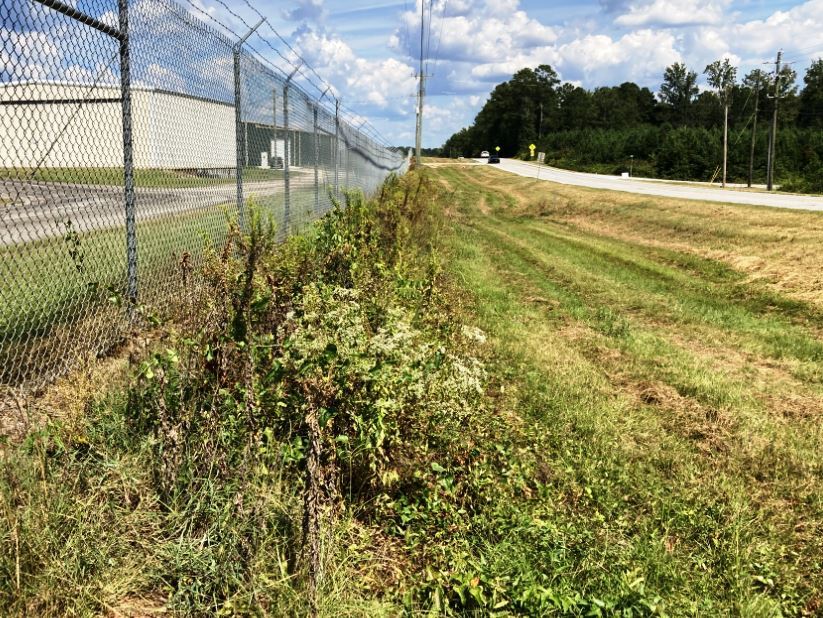
Download Herbicide Capabilities Overview.
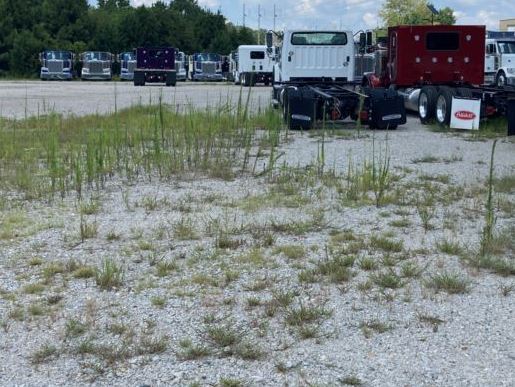

As a commercial property manager, keeping your properties free of weeds is a constant challenge. Traditional postemergence herbicides, which kill foliage on contact, are effective in eliminating existing weed growth, but do not prevent new germination. This means that regular spraying is necessary to maintain a weed-free environment. At VegClear, we understand this challenge. We have developed a solution that is both effective and efficient. Our non-Roundup postemergence products are designed for initial vegetation knock down. They can be combined with a preemergence herbicide additive, which significantly reduces the frequency of recurring spray treatments. Additionally, our approach to spot treating existing growth, rather than blanket spraying an entire area, ensures that the herbicide is only applied where it is needed. Thus, reducing the amount of herbicide concentrate used. By gradually building a preventative barrier to the ground, our method can limit herbicide application and prevent oversaturation, while still effectively preventing weed intrusion.
If you are looking for a comprehensive and effective weed control solution for your commercial properties, look no further than VegClear. Contact us today to learn more about how we can help you maintain a weed-free environment with minimal effort.
As a commercial property manager or an industrial facilities supervisor, maintaining a weed-free environment in bare ground areas such as gravel yards, fence lines, and driveways can be difficult. Traditional postemergence sprays alone are not used alone to achieve long-term results. We understand this challenge and for areas that require longer term control, we have developed a comprehensive vegetation control approach to growth management that utilizes targeted long-lasting soil active products. Our proprietary tank mixes contain a combination of Glufosinate, Imazapyr, Triclopyr, or Diquat at precise levels, which provides a multi-tiered approach to controlling weeds long term. Our residual applications last no more than a year, by design, after spraying. This approach provides a barrier for an entire growing season in the Southeast.
One key benefit of our approach is the use of a smaller amount of chemical concentrate than using any one of these products alone. Depending on the application, these active ingredients are used at varying concentrations, ensuring that the goal of reduced and eliminated vegetation is achieved in the most environmentally friendly way possible.
Ideal conditions for application include bare, moist soil or several hours prior to expected light rainfall. The combination of preventatives and postemergence knockdown herbicides deliver an effective kill to existing plants, and also ensures the sprayed vegetation will not recover. As a bonus, the soil is enriched with simple compounds that stop seedlings in their tracks upon germination, leading to long-term control of weeds. If you are looking for a comprehensive and effective weed control solution for your commercial properties, we have the answer at VegClear. Contact us today to learn more about how we can help you maintain a weed-free environment with minimal effort.
Foliar and systemic spray products are two of the most common products in industrial vegetation management, providing fast-acting and targeted results. Foliar spray products work on contact, and are applied directly to the leaves or blades of the target vegetation to produce a kill at the site of absorption intended to minimize effects to non target plants. However, due to the touch and kill nature of these herbicides, caution must be taken by the applicator as to not over-spray or introduce drift that contacts other plants or to non-target low growing plants on the soil below and around the site of treatment.
On the other hand, systemic herbicides are absorbed into the plant and transferred throughout internal carrier systems. This type of herbicide requires only a portion of the healthy, actively growing, foliage to be in contact with the applied herbicide in order to produce a kill of the entire target plant. Systemic herbicides are generally more effective than foliar, but the rate of brown out, or visual decline of the vegetation, is slower, therefore it is usually only used when quick visual confirmation isn't a requirement and the property manager understands the thorough, yet progressive nature of a more holistic control process.
VegClear provides professional services to assess each job and commercial property in order to determine which type of product should be used, taking into consideration the unique pros and cons of each method. Through our years of expertise, businesses and municipalities can be sure of the most effective, safe, and efficient industrial vegetation management on their site.
Safety is a top priority for VegClear and our crews, clients, and local residents. We use only EPA-approved herbicides for industrial vegetation management. These products are effective and non-carcinogenic (based on published EPA underlying scientific findings), and break down in the environment quickly to reduce soil erosion. We offer various formulations of non-Roundup herbicides, including liquid concentrate, solid, granular, and ready-to-use liquid. Our applications are suitable for agricultural, commercial and right-of-way settings using various methods, including hand sprays, broadcast sprayers, shielded and hooded devices. Additionally, we rely on precise applicators, drip and sponge bars, and controlled droplet tools. This provides a safe, reliable, and cost-effective solution to managing invasive and noxious weeds in a variety of settings, and is an integral part of integrated pest management. By using these approaches, we can reduce the need for mechanical methods to maintain natural areas, making industrial vegetation management an important part of environmental conservation.
Industrial vegetation management and bare ground weed control services are an effective and cost-efficient solution for eliminating unwanted plants and weeds. Bareground herbicides, also known as soil sterilants, are chemical products that provide total vegetation control (TVC) when applied according to label instructions. These herbicides can last for long periods of time and can prevent germination for several months up to a year.
Bareground herbicide management must consider a number of factors, one of them being preventing herbicide resistance to target and non target vegetation on the treated property. Critical to the long term success of a specific commercial vegetation control program, as well as industry execution as a whole, is varying the mode of action (PDF) throughout a program's existence.
Industrial vegetation management and bare ground weed control services are an ideal solution for preventing damage and obstructions caused by vegetation, as well as for providing safety to crews in certain areas. When applied strategically and with extensive training, bare ground herbicides can provide long-term benefits and cost savings, making them an attractive option for many businesses seeking a weed control service provider.
Common Herbicide Active Ingredients and Their Use Listed Below. For a more detailed summary of the most commonly used herbicides used by VegClear teams, see the section below. Vegetation Control Herbicides Suitable For Industrial, Commercial & Multiuse Properties.
Format Key: Active Ingredient
Weeds Controlled
Where Used
Notes
Glufosinate
Non-Selective, postemergence
Highly effective non-selective, postemergence herbicide, is widely trusted for its broad-spectrum control against various vegetation, including broadleaves and grasses.
Its versatility positions it as a common choice for both large area control and precise spot treatments, especially when used as the base active ingredient for precision tank mixes.
Caution is advised during application to prevent unintended damage, particularly through direct contact with non-target plants.
Trifluralin
Selective, preemergence.
Trifluralin, a selective preemergence herbicide often applied in its granular state, stands out for its prowess against most annual weeds.
Ideal for use in plant beds, commercial gardens, and industrial turf grass lawns, it provides targeted selective control without compromising the health of established garden plants.
To enhance effectiveness, it's advisable to water the soil after application, ensuring the herbicide is absorbed and activated to its full potential, particularly in its common granular form.
Benefin
Selective, preemergence.
Benefin, a selective preemergence herbicide, is effective against a broad spectrum of annual weeds, making it valuable for areas requiring aggressive crabgrass control.
Widely used in industrial and commercial property maintenance, its targeted action ensures weed management without harming desirable vegetation.
Dithiopyr
Selective, preemergence.
Dithiopyr, a selective preemergence herbicide, is specifically formulated to combat crabgrass, oxalis, and annual bluegrass
Dithiopyr is particularly effective on spurge (a leafy lawn weed that resembles a "mini tree" and can rapidly expand horizontally from a single stem if left unchecked).
Labeled for use on municipal lawns and commercial landscapes, it offers a foliar application method compatible with various turf-grass species.
While it excels in precision weed control, its efficacy is maximized when target plants are actively growing, requiring absorption for optimal results.
Diquat (Aquatic & Terrestrial)
Non-Selective, postemergence.
Diquat (and related, Paraquat), non-selective postemergence herbicides, demonstrate broad-ranging efficacy against broadleaf, grass, and young brush (and aquatic plants when applied by a licensed applicator).
Ideal for industrial and commercial beds, curbs, and gravel areas, these herbicides deliver comprehensive weed and vegetation control, often combined with other active ingredients for enhanced efficacy.
Careful consideration is needed due to potential risks to the roots of certain trees, especially around the drip line and root systems of established woody vegetation.
Dicamba
Selective, postemergence.
Dicamba, a selective postemergence herbicide, is formulated for effective control against broadleaf plants commonly found in pastures.
Suited for lawns and farms with versatile application methods, including hand spray/wand and broadcast, it offers precise selective targeting while minimizing impact on non-target ornamentals.
Applicators should remain mindful of its potential impact on the roots of certain plants, even during dormancy.
Fluazifop
Selective, postemergence.
Fluazifop, a selective postemergence herbicide, is engineered for efficient control of grasses, including resilient varieties like Bermudagrass and Zoysia.
Recommended for use on broadleaf groundcovers or commercial landscape beds, it is most effective during the active growth phase of weedy grasses.
Due to its effectiveness in controlling horizontally spreading grasses, caution is needed to avoid applications near sodded lawns and areas containing desirable perennial turf.
Not a fit for agriculture settings including poultry farm operations because of the grazing restrictions
2,4-D or 2,4-Dichloro-acetic acid
Selective, postemergence.
2,4-D, or 2,4-Dichloro-acetic acid, is a potent selective postemergence herbicide with a focus on broadleaf plants.
Applicable in parks, farms, pastures, municipal lawns, and commercial turf settings, its systemic action allows it to travel through the plant's carrier systems for comprehensive weed elimination.
Remedy (Triclopyr)
Selective, postemergence.
Products containing Triclopyr, including Remedy, are selective postemergence herbicides designed for effective control of brush, small trees, and broadleaf plants.
Notably effective on vines like Kudzu, English Ivy, and Morning Glory, these products provide a reliable solution when mixed and applied correctly.
Ideal for natural and industrial property areas, their systemic action ensures the eradication of entire plants by traveling through their vascular systems after absorption through foliar spray.
This targeted and comprehensive approach makes them reliable choices for managing vegetation, particularly intrusive vines and trees, while preserving low-growing grasses prized for wildlife compatibility and erosion mitigation.
Herbicidal Oils (e.g., clove, lemongrass, eugenol) Organic
Nonselective, postemergence.
Herbicidal oils, such as clove, lemongrass, and eugenol, are potent non-selective, postemergence herbicides.
When applied without a surfactant, their effects can be inconsistent after a single application, often necessitating multiple follow-up treatments.
Specifically effective on young broadleaves, these oils excel in applications within cracks, crevices, or as targeted spot treatments, making them suitable for on-site property maintenance.
These organic options are environmentally friendly, working through contact with plant material, providing a sustainable approach to weed control.
For optimal performance, it's recommended to apply these oils when temperatures are above 70°F, maximizing their efficacy.
VegClear Utilizes Selective & Non Selective Herbicides
There are several dozen USDA, EPA, & State approved non-restricted herbicides that are used to control most all types of unwanted vegetation on commercial property. The list below includes some of the more commonly used products and active ingredients available to meet the needs of industrial grounds and commercial property managers. Some are selective herbicides and other products are non selective herbicides (meaning they provide TVC, Total Vegetation Control) with as few as one to two applications. Depending on the scope of the project, VegClear Technicians utilize a precision mixture of from one to several of these products at varied concentrations for combined applications from a single tank mix applied in tandem. In other cases, depending on whether specific chemicals need to be applied unmixed, individual follow up applications are scheduled and sprayed back to back, usually about a month apart. There are many considerations for strategic application of the right chemicals, in the right amounts, in the right order, at the right time of year. All these combine to structure a successful vegetation control program on your site. If you'd like to discuss your project, Contact Us today.
Triclopyr based products are often used for Brush Killer applications. It is a post-emergent herbicide used to control thick vegetation in various areas. It is formulated with the active ingredient Triclopyr and is ideal for clearing woody plants, brush, and broadleaf weeds. Garlon 4 Ultra Herbicide is the liquid ester formulation for foliar and basal bark applications. It is effective on actively growing brush by penetrating the bark and entering the cambium layer. Also effective as a late-season application.
Triclopyr based Brush Killers can be used in forests, on permanent grass pastures, rangelands, conservation reserve programs (CRP acres), right-of-ways, and in non-crop areas and ornamental turf, industrial sites and non-irrigation ditch banks.
Ingredients: Triclopyr Butoxyethyl ester 39.5-61.6%
Formulation Type: Ester.
Mode of Action: 4
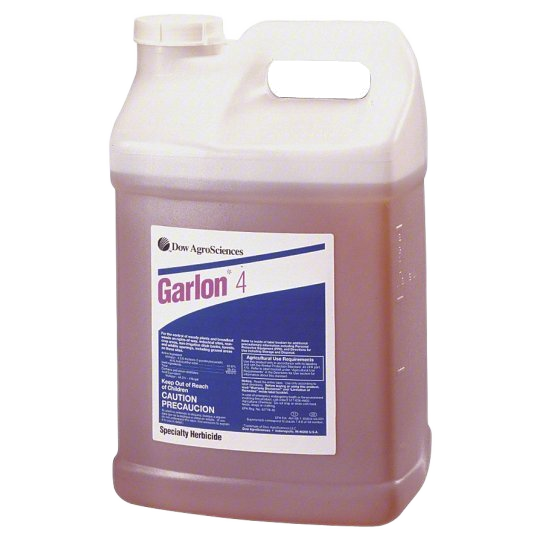
Garlon 4 Ultra 60.45% Triclopyr Specialty Herbicide was developed by Dow AgroSciences. It performs on unwanted vegetation along roadsides, industrial rights-of-way and similar non-crop sites. The formulation improves availability of the active ingredient for right-of-way vegetation management.
Garlon 4 Ultra is marketed to meet the needs of vegetation management professionals, the public and the environment. The recipe uses a plant-derived solvent as a proactive measure to reduce organic compounds and petroleum distillates, reduce odor and improve overall performance.
Alder, Arrowwood, Ash, Aspen, Bear Clover, Beech, Birch, Black gum, Black Medic, Blackberry, Blackbrush, Boxelder. Brazilian Pepper, Buckthorn, Bull Thistle, Burdock, Canada Thistle, Cascara, Ceanothus, Cherry, Chicory, Chinquapin, Choke Cherry, Cinquefoil, Clover, Cottonwood, Crataegus, Creeping Beggarweed, Curly dock, Dandelion, Dogfennel, Dogwood, Douglas fir, Eastern Persimmon, Elderberry. Elm, Field Bindweed, Gallberry, Goldenrod, Granjeno, Ground Ivy, Guajillo, Guava Tulip Poplar, Hawthorn, Hazel, Hickory, Hornbeam, Huisache, Kudzu, Lambsquarters, Lespedeza, Locust, Madrone, Maples, Matchweed, Milkweed Vine, Mulberry, Mustard, Oaks, Osage Orange, Oxalis, Pepper Vine, Persimmon, Pine, Plantain, Poison Ivy, Poison Oak, Poplar, Purple Loosestrife, Ragweed, Salmonberry, Salt Cedar, Saltbush, Sassafras. Scotch Broom, Sericea Lespedeza, Smartweed, Sulfur Cinquefoil, Sumac, Sweet Clover, Sweet Gum, Sweetbay Magnolia, Sycamore, Tan Oak Gorse, Thimbleberry, Tree-of-Heaven, Tropical Soda Apple, Trumpet Creeper, Twisted Acacia, Vetch. Virginia Creeper, Wax Myrtle, Wild Carrot, Wild Lettuce, Wild Rose, Wild Violet, Willow, Winged elm, Yarrow.
Ideal for use on large land areas, where over spray is not a concern. It is is a post-emergent non-selective herbicide. When sprayed on the targeted weeds, the solution works by contact, soaking onto the plant and killing it. It is used to remove annual and perennial weeds, shrubs, trees and woody plants.
Active Ingredient: Glufosinate 20.0% - 24.5%
Formulation: Soluble Concentrate.
Mode of Herbicide Action: 10
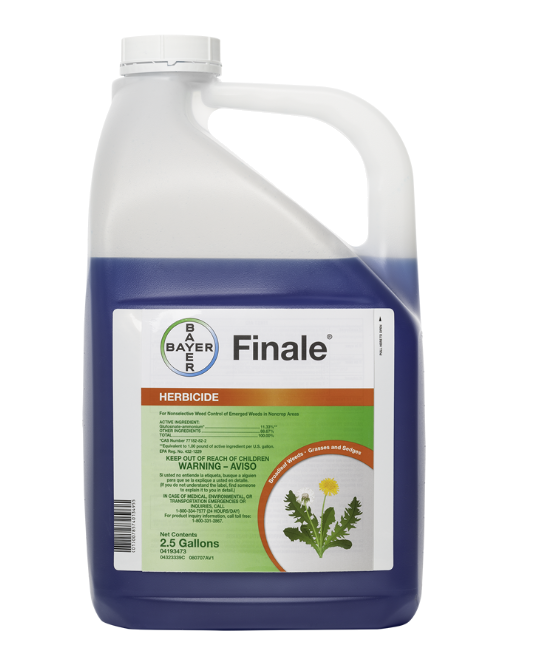
Annual Bluegrass, Annual Fleabane, Annual Sowthistle, Barley, Barnyardgrass, Bittercress, Black Nightshade, Blue Mustard, Bluegrass, Boradleaf Signalgrass, Burcucumber, Buttercup, Caroetweed, Carolina Foxtail, Carolina Geranium, Cheat, Chervil, Chickweed, Cocklebur, Common Groundsel, Common Ragweed, Corn, Corn Speedwell, Crabgrass, Cutleaf Rvening Primrose, Downy Brome, Dwarfdandelion, Eastern Mannagrass, Eclipta, Fall Panicum, Falsedandelion, Fiddleneck, Field Pennycress, Field Sandbur, Filaree, Fivehook Bassia, Florida Pusley, Foxtail, Giant Ragweed, Goosegrass, Grain Sorghum, Hairy Fleabae, Hairy Nightshade, Hemp Sesbania, Henbit, Hophornbeam Copperleaf, Horseweed, Marestail, Itchgrass, Japanese Brome, Jimsonweed, Jointed Goatgrass, Junglerice, Knotweed, Kochia, Ladysthumb Smartweed, Lambsquarters, Little Barley, London Rocket, Mayweed, Morning Glory, Oats, Overwintered Wheat, Panicum Browntop, Pennsylvania Smartweed, Pigweed Species, Plains, Tickseed coreopsis, Prickley Lettuce, Prostrate Spurge, Purslane, Purslane Speedwell, Red Rice, Rough Fleabane, Russian Thistle, Rye, Ryegrass, Seedling Jognsongrass, Shattercane, Shepherdspurse, Sicklepod, Smallseed Falseflax, Spanishneedles, Spotted Spurge, Sprangletop, Spurred Anoda, Stinkgrass, Sunflower, Tansy Mustard, Teaweed / Prickly Sida, Texas Panicum, Tumble Mustard, Umbrella Spurry, Valvitleaf, Virginia Copperleaf, Virginia Pepperweed, Waterhemp, Wheet, Wild Mustard, Wild Oats, Witchgrass, Woolly Cupgrass, and Yellow Rocket.
Arsenal Isopropylamine salt of Imazapyr Herbicide controls trees and brush alongside trimming or when traditional mechanical methods are insufficient. Non herbicide mitigation causes re-sprouts and increased stem densities leading to more mowing. These costs can be overcome with property applications of this product. Herbicide-based programs with Arsenal control a broad spectrum of brush species and helps reduce costs. Arsenal prevents re-sprouting, eliminates re-treats and saves money on treatment and labor. And, because Arsenal is a low-volume herbicide, it helps manage public concerns and wildlife habitats as well. Imazapyr is not a contact killer. It works through the ground, so it can take a while to kill existing weeds. Most brands containing Imazapyr are low-volume use herbicides, which helps manage public concerns and wildlife habitats as well.
Active Ingredients: Isopropylamine Salt of Imazapyr 53.1%
Chemical Formulation: Suspension aqueous solution.
Active Ingredient Mode of Action: 2
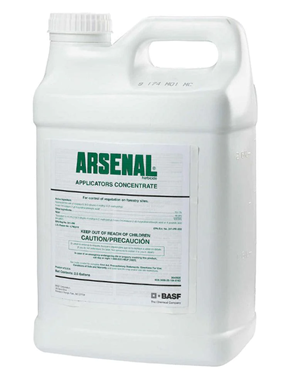
Alder, Alligatorweed, American, Annual, Arrowweed, Ask, Aspen, Autumn, Bahiagrass, Bald, Bamboo, Barley, Barnyardgrass, Beardgrass, Beech, Bermudagrass, Big, Bigleaf, Bindweed, Birch, Black, Bluegrass, Bluestem, Boxelder, Brazilian, Broadleaf, Brome, Bromw, Broom, Buckwheat, Bull, Burclover, Burdock, Bursage, Camelthorn, Camphorweed, Canada, Canarygrass, Cannon, Carolina, Carpetweed, Carrot, Cattail, Ceanothis, Cheat, Cherry, Chickweed, Chinaberry, Chinese, Chinquapin, Clover, Cocklebur, Cogongrass, Common, Cordgrass, Cottonwood, Creeper, Crowfootgrass, Cudweed, Cupgrass, Cypress, Daisy, Dallisgrass, Dandelion, Desert, Diffuse, Dock, Dog, Dogfennel, Dogwood, Downy, Dropseed, Eucalyptus, Fall, Fennel, Fescue, Fiddleneck, Filaree, Fleabane, Florida, Foxtail, Fuse, Geranium, Giant, Goldenrod, Goosefoot, Goosegrass, Grape, Gray, Guineagrass, Gum, Hawthorn, Heaven, Hedge, Henbit, Hickory, Hoary, Honeysuckle, Hop, Horseweed, Huckleberry. Indian, Italian, Itchgrass, Ivy, Japanese, Johnsongrass, Junglerice, Kentucky, Knapweed, Knotweed, Kochia, Lambsquarters, Lespedeza, Lettuce, Little, London, Loosestrife, loosestrife, Lovegrass, Lyonia, Madrone, Mallow, Maple, Melaleuca, Milkweed, Miners, Morningglory, Mouseear, Muhly, Mulberry, Mullein, Mullien, Mustard, Nettle, Nettleleaf, Nightshade, Oak, Oats, of, Olive, Orchardgrass, Oxeye, Panicum, Parsnip, Peppertree, Pepperweed, Phragmites, Pigweed, Plantain, Poison, Pokeweed, Popcorn-Tree, Poplar, Praieie, Prairie, Primrose, Privet, Prostrate, Puncturevine, Purple, Purse, Purslane, Pusley, Pweaimmon, Quackgrass, Rabbitbrush, Ragweed, Red, Redvine, Reed, Rocket, Rose, Rush, Russian, Ryegrass, Saltbrush, Saltbush, Saltgrass, Saltscedar, Sand, Sandbur, Sassafras, Shepherd's, Signalgrass, Silverleaf. Skeletonweed, Smartweed, Smooth, Snakeweed, Sorrell, Sourwood, Sowthistle, Spp, Sprangletop, Spurge, Starthistle, Stinging, Sumac, Sunflower, Sweet, Sweetgum, Sycamore, Tallow, Tanoak, Tansymustard, Texas, Thistle, Threeawn, Timothy, TiTi, Torpedograss, Tree, Turnip, Vasseygrass, Velvetleaf, Vervain, Virginia, Western, Wild, Wirestem, Witchgrass, Woodsorrel, Woolly, Woollyleaf, Woolyleaf, Yellow, Adler, Crabgrass, Feathertop, Field, Filaree, Panicum, and Paragrass.
Arsenal Herbicide is available only as an applicators concentrate and controls weeds in forestry sites and other non-crop areas. It's labeled as a low-volume herbicide. This means that when used as labeled it has lesser impact to non target plants, animals and the environment. It contains imazapyr, a nonselective chemical that moves through the weeds and disrupts protein synthesis and cell growth. This chemical kills the weeds and allows pines and other beneficial trees gain root space.
Tribune Diquat Herbicide is a nonselective, nonvolatile and fast-acting weed killer with results usually visible within days. It’s great for both weeds and grasses and can be used commercial applications. Tribune can also be applied as an aquatic herbicide to control pond algae and weeds while remaining environmentally safe. It can be applied in and around swimming areas, docks, ponds, lakes, drainages, fountains, and greenhouses. Paraquat is a post-emergent herbicide used to control weeds on both dry land and aquatic sites. It is ideal to use in ponds, lakes, or marshes to keep unwanted vegetation from taking over.
Primary Ingredient: Diquat Dibromide 37.3%+
Formulation Style: Emulsifiable Concentrate (EC)
Product Mode of Action: 22
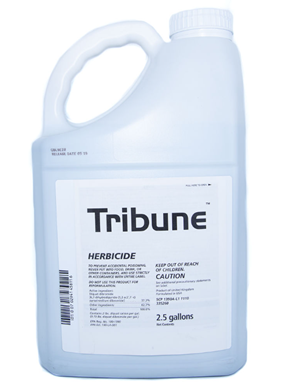
Bladderwort, hydrilla, watermilfoils, pondweeds, coontail, elodea, Brazilian elodea, naiad, algae, water lettuce, water hyacinth, duckweed, salvinia, pennywort, frog's bit, cattails, and more. Dibromide Herbicide controls and kills the following land weeds: little barley, annual bluegrass, rescue grass, sixweeds fescue. henbit, buttercup, and Carolina geranium. Clover, Cocklebur, Cogongrass, Common, Cordgrass, Cottonwood, Creeper, Crowfootgrass, Cudweed, Cupgrass, Cypress, Daisy, Dallisgrass, Dandelion, Desert, Diffuse, Dock, Dog, Dogfennel, Adler, Crabgrass, Feathertop, Field, Filaree, and Panicum.